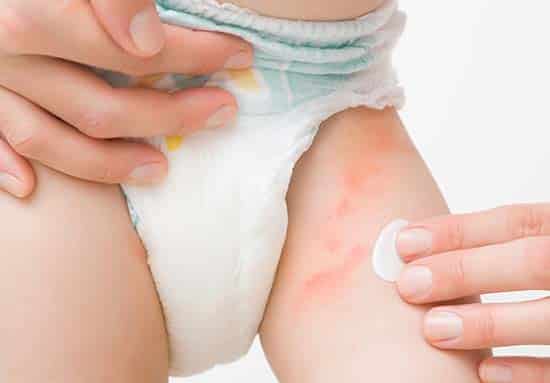Foods that cause diaper rash in breastfed babies
Food and Diaper rashes – Overview
One of the major sources of discomfort to babies is diaper rashes. Diaper rashes are the several red patches of inflamed skin that you find on your baby’s buttocks. They cause serious discomfort to the baby and consequently make diaper changing difficult. In addition, the baby becomes irritated at every turn and cries out angrily most of the time. You probably have observed your baby get angry at any little attempt to change the diaper.
Like any parent would do, you check the baby’s buttocks, and you discover red patches. You proceed to apply the correct soothing cream, baby bath, or lotion. However, you are confused; your baby is not exposed to all the common triggers of diaper rashes. Their diapers are not dirty neither are they wet.
What do you do? What could be the cause?
This post may contain affiliate links. For my full disclosure policy click here.
In the absence of any other trigger, you should watch the sort of food you give your baby. Yes! You read right; diaper rashes can be triggered in babies by some certain type of food. It is more so in breastfed babies. The production of rash in your baby’s buttocks (and some other corresponding skin conditions) due to certain food items is technically due to food sensitivity.
Food sensitivity in babies – How does it work?
Food sensitivity is simply the human body’s response when it does not properly understand the contents of the ingested food. That is, it is the array of reactions your body would produce when the food components are foreign, strange, and are not digested properly. It is sometimes confused with a food allergy because of similarity in response.
However, it is different from allergies by the severity of response and the speed of response.
A whole lot of food items are foreign to a baby’s digestive system. This is especially true for babies whose mothers still breastfeed.
It is normal if as a mum you introduce new food items to your baby as part of weaning. It is pretty important that your baby gradually gets exposed to eating new food. However, some of these food items predispose your baby to diaper rashes and a myriad of other skin reactions. This is due to any of the following;
The baby does not have the right set of enzymes to digest the food. This is the most common cause in babies; their bodies have not synthesized some digestive enzymes yet.
The immune system reacts to foreign additives that it perceives as threats. This is majorly a reaction of IgG immunoglobulin. Examples of some of these include parabens.
The food item has a PH that alters the acidic balance of the babies’ digestive tract. Drastic fluctuations in the baby’s acid-base balance trigger a corresponding acidic poop that may induce diaper rashes.
Food item has some components that hint at triggering the baby’s allergies. For example, the body may be sensitive to things like caffeine and similar chemicals. Again, this cause may be traceable; babies may have the same allergies as their parents.
NOTE – In some extreme cases, diaper rashes may appear as a reaction to certain food allergies in your baby. In those instances, you should take immediate caution to visit a professional. In these instances, the rashes appear fast and intense. Apart from the intensity of the rashes, the baby’s body may also heat up, redden all over or produce a unique reaction to allergies.

Foods that cause diaper rash in breastfed babies: Top on the list
Now that you have understood the mechanism of food-caused diaper rash production let’s examine some food items that are likely to trigger it.
Dairy and Soy
A baby may get diaper rashes from dairy products and soy on two conditions; If the baby is lactose intolerant or if the baby has lactose (milk allergy). This is not very common in babies because their intestinal biochemistry is optimized for milk/lactose digestion. Breaking out of diaper rash due to dairy product consumption is not most times a function of the immune system. It is, instead, a deficiency of the intestinal system. Your baby may develop diarrhea and consequently diaper rashes in this situation.
Wheat
Wheat is one of the common food items given to the baby while making the baby less dependent on breast milk and adjusting to the new normal. Wheat contains four protein types – albumin, glutens, gladin, and globulin. When these proteins – still somewhat foreign – contact the immune system, the immune system may consider them dangerous and trigger responses that may include diaper rashes. In addition, gluten is notorious for triggering allergies – especially by making the body produce histamine as a defense mechanism. However, babies often outgrow food sensitivity (or allergies) caused by wheat.
Egg
Eggs can trigger diaper rashes, primarily in babies with egg allergies. In some babies, the immune system cannot distinguish between the egg’s yolk and disease-causing pathogens. This automatically triggers the production of IgE, which in turn causes bodily reactions that include diaper rashes.
Corn
The baby may get diaper rashes due to the body’s sensitivity to corn (or, in extreme cases, corn allergy). Most baby feeds and weaning food items are corn-based. Due to that, corn-triggered diaper rashes may prove a little tricky to deal with. Aside from food items, some baby cosmetics, oils, and bath materials are also corn-based. In a baby sensitive or allergic to corn, the body’s immune system takes its protein components for dangerous pathogenic intrusion. This triggers bodily reactions, which always include diaper rashes.
Peanut (in peanut butter)
Like all other food items with various protein components, the immune system mistakes the protein ingestion for pathogenic intrusion. Peanut butter is one of the most common food items given to babies, it is not surprising that peanut sensitivity is one of the most common triggers of diaper rashes in babies.
Beans (Legumes generally)
Beans are very rich in protein. Like other protein-rich food items, the baby may just happen to be sensitive to it due to the body’s inability to differentiate between proteins and pathogens. However, food items with a wider variety of protein components are more likely to trigger rashes due to sensitivity.
Fruits that slightly distort acid balance
When your baby develops very nasty angry-looking diaper rashes, acidic food items are most likely the cause. These food items are capable of triggering diaper rashes in babies because they are inherently acidic. Upon introduction into the baby’s body, such food item slightly causes the body to attempt an acid-base balance reset. This occurs, especially in the intestine.
This may sometimes (as in the case of sensitivity) cause an inability of the digestive enzymes to process the food item. The result of that is an acidic stool. In addition, an acidic poop – when excreted over time – is capable of causing rashes in the child’s buttocks.
Examples of fruits that fall into this category include pineapple, strawberries, oranges, tangerines, tomatoes, raisins, grapes, peaches, plums, tarts, apples, and other related food items.
On the other hand, food items may trigger diaper rashes indirectly without necessarily triggering an immune response or altering the body’s acid-base balance.
Some food items are prone to triggering diarrhea if consumption is not moderate. This happens in babies as well as in adults. A baby that suffers from diarrhea is predisposed to having diaper rashes. Due to this, you may need to watch out for food items that may disturb the bowels or trigger diarrhea in babies.
Some examples of the above mentioned include cow’s milk-based formula dairy products (except yogurt), peaches, pears, pea, apricot, prune, plums, apple juice, pear juice, cherry juice, beans, wheat cream, and so on.
Finally, food items that contain artificial additives (like sweeteners, parabens, gluten, and GMA) are more likely to induce diaper rashes by triggering allergies when compared to others.
Also Read:
How long does it take to wean a baby
How to prevent urine leakage from diaper
Baby cries in pain when changing diaper

How To Deal With Food Triggered Diaper Rashes In Babies
The major challenge parents encounter is how to identify which food is responsible for the rash. To detect this quickly, you can space out the number of days between the times when you introduce new food items into your baby’s meal sequence.
This makes identifying which food triggers the rash (and how intense the rashes can get). Of course, some of these food items are very significant for a child’s growth, so you can’t just scrape them off the list. Instead, you can try re-introducing them after a couple of days (in little quantities).
In doing that, the body would probably adjust itself to the food item (in the situation of food insensitivity).
Now, what if the rashes have broken out badly? What if the baby gets very sick from various red spots on the buttocks? Don’t panic; you should adopt the conventional methods of rash treatment (after withdrawing the food item responsible).
Essentially, use diaper rash creams, employ a barrier between diaper and skin (maybe a lotion, oil) to limit contact. If all the conventional methods prove ineffective (maybe in a severe allergic reaction), you can visit a pediatrician for professional help.
Conclusion
Diaper changing does not need to be hell (for both the baby and the mother). However, for the sake of ease, peace, and healthy baby skin, you may need to monitor the food items your baby consumes closely. There are babies, after all.

